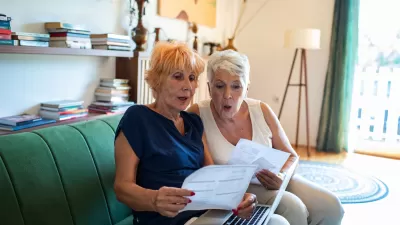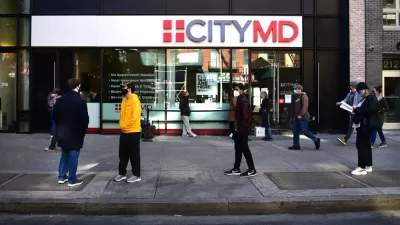Using a series of mid-century guidebooks, a new project seeks to uncover historic LGBTQ spaces around the country.

Eric Gonzaba, a historian and professor at California State University, Fullerton (CSUF), has launched a project aimed at "uncovering and preserving hidden histories" in the LGBTQ community as presented in "a series of travel guides published by Bob Damron to map historic queer spaces across the United States," also known as the 'Gay Guides.'
As Marianne Dhenin writes in Next City, the guides were produced by Bob Damron, "a traveling businessman who took note of the gay or at least gay-friendly bars, bathhouses, theaters, bookstores, restaurants, and shops he discovered on his many trips." Now, Mapping the Gay Guides has made the guides into an interactive map loaded with information about important sites and its importance in gay history.
Since its launch in February 2020, Mapping the Gay Guides has dropped hundreds of pins on its interactive map across all 50 states, Washington D.C., Guam, Puerto Rico, and the Virgin Islands (Damron did not distinguish between entries in the U.S. Virgin Islands and the British Virgin Islands, so neither does Mapping the Gay Guides) from the 1965 to 1980 address books. The project received a $350,000 grant from the National Endowment for the Humanities (NEH) in April 2021, which will allow it to spend the next three years digitizing, transcribing, and geolocating data from the 1981 to 2000 guides.
In working on the project, Gonzaba also felt motivated by "a fairly depressing moment in queer communities across the country dealing with the collapse of LGBTQ spaces" as many businesses shuttered, some permanently, during the pandemic. But he cautions that understanding the context of the guides matters: they "were authored by a gay, white man from the relatively progressive city of San Francisco" with his own biases. "Mapping the Gay Guides exemplifies the many colorful possibilities of a digital history project handled with appropriate care. Like other creative digital projects, it can give users a fresh perspective on their cities" and uncover hidden and suppressed histories.
FULL STORY: A New Project Is Bringing the Gay ‘Green Book’ Online

Manufactured Crisis: Losing the Nation’s Largest Source of Unsubsidized Affordable Housing
Manufactured housing communities have long been an affordable housing option for millions of people living in the U.S., but that affordability is disappearing rapidly. How did we get here?

Americans May Be Stuck — But Why?
Americans are moving a lot less than they once did, and that is a problem. While Yoni Applebaum, in his highly-publicized article Stuck, gets the reasons badly wrong, it's still important to ask: why are we moving so much less than before?

Using Old Oil and Gas Wells for Green Energy Storage
Penn State researchers have found that repurposing abandoned oil and gas wells for geothermal-assisted compressed-air energy storage can boost efficiency, reduce environmental risks, and support clean energy and job transitions.

Updating LA’s Tree Rules Could Bring More Shade to Underserved Neighborhoods
A new USC study finds that relaxing Los Angeles’ outdated tree planting guidelines could significantly expand urban tree canopy and reduce shade disparities in lower-income neighborhoods, though infrastructure investments are also needed.

California's Canal Solar Projects Aim to Conserve Resources and Expand Clean Energy
California’s Project Nexus has begun generating electricity from solar panels installed over irrigation canals, with researchers and state agencies exploring statewide expansion to conserve water and boost clean energy production.

HHS Staff Cuts Gut Energy Assistance Program
The full staff of a federal program that distributes heating and cooling assistance for low-income families was laid off, jeopardizing the program’s operations.
Urban Design for Planners 1: Software Tools
This six-course series explores essential urban design concepts using open source software and equips planners with the tools they need to participate fully in the urban design process.
Planning for Universal Design
Learn the tools for implementing Universal Design in planning regulations.
Heyer Gruel & Associates PA
City of Moreno Valley
Institute for Housing and Urban Development Studies (IHS)
City of Grandview
Harvard GSD Executive Education
Salt Lake City
NYU Wagner Graduate School of Public Service
City of Cambridge, Maryland





























